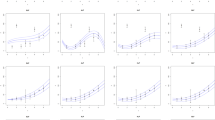Abstract
In this paper we present a crisp-input/fuzzy-output regression model based on the rationale of generalized maximum entropy (GME) method. The approach can be used in several situations in which one have to handle with particular problems, such as small samples, ill-posed design matrix (e.g., due to the multicollinearity), estimation problems with inequality constraints, etc. After having described the GME-fuzzy regression model, we consider an economic case study in which the features provided from GME approach are evaluated. Moreover, we also perform a sensitivity analysis on the main results of the case study in order to better evaluate some features of the model. Finally, some critical points are discussed together with suggestions for further works.


Similar content being viewed by others
References
Benítez, J.M., Martín, J.C., Román, C.: Using fuzzy number for measuring quality of service in the hotel industry. Tour. Manag. 28(2), 544–555 (2007)
Bernardini Papalia, R., Ciavolino, E.: Gme estimation of spatial structural equations models. J. Classif. 28, 126–141 (2011)
Buckley, J.: Fuzzy Statistics, vol. 149. Springer, Heidelberg (2004)
Celmiņš, A.: Least squares model fitting to fuzzy vector data. Fuzzy Sets Syst. 22(3), 245–269 (1987)
Chan, L., Kao, H., Wu, M.: Rating the importance of customer needs in quality function deployment by fuzzy and entropy methods. Int. J. Prod. Res. 37(11), 2499–2518 (1999)
Chang, Y.H., Yeh, C.H.: A survey analysis of service quality for domestic airlines. Eur. J. Oper. Res. 139(1), 166–177 (2002)
Cheng, H., Chen, J.: Automatically determine the membership function based on the maximum entropy principle. Inf. Sci. 96(3), 163–182 (1997)
Ciavolino, E., Al-Nasser, A.: Comparing generalised maximum entropy and partial least squares methods for structural equation models. J. Nonparametr. Stat. 21(8), 1017–1036 (2009)
Ciavolino, E., Dahlgaard, J.: Simultaneous equation model based onthe generalized maximum entropy for studying the effect of management factors on enterprise performance. J. Appl. Stat. 36(7), 801–815 (2009)
Ciavolino, E., Salvatore, S., Calcagnì, A.: A fuzzy set theory based computational model to represent the quality of inter-rater agreement. Qual. Quant. 47, 1–16 (2013)
Coppi, R.: Management of uncertainty in statistical reasoning: the case of aegression analysis. Int. J. Approx. Reason. 47(3), 284–305 (2008)
Coppi, R., Gil, M.A., Kiers, H.A.L.: The fuzzy approach to statistical analysis. Comput. Stat. Data Anal. 51, 1–14 (2006)
Diamond, P.: Fuzzy least squares. Inf. Sci. 46(3), 141–157 (1988)
Dubois, D., Prade, H., Harding, H.: Possibility Theory: An Approach to Computerized Processing of Uncertainty. Plenum, New York (1988)
D’Urso, P.: Linear regression analysis for fuzzy/crisp input and fuzzy/crisp output data. Comput. Stat. Data Anal. 42(1–2), 47–72 (2003)
D’Urso, P., Gastaldi, T.: A least-squares approach to fuzzy linear regression analysis. Comput. Stat. Data Anal. 34(4), 427–440 (2000)
Golan, A.: Information and Entropy Econometrics–A Review and Synthesis, vol. 2. Now Publishers Inc., Norwell (2008)
Golan, A., Judge, G.: Maximum Entropy Econometrics Robust Estimation with Limited Data. Wiley, Chichester (1996)
Golan, A., Judge, G., Karp, L.: A maximum entropy approach to estimation and inference in dynamic models or counting fish in the sea using maximum entropy. J. Econ. Dyn. Control 20(4), 559–582 (1996)
Golan, A., Karp, L., Perloff, J.: Estimating coke’s and pepsi’s price and advertising strategies. J. Bus. Econ. Stat. 18(4), 398–409 (2000)
Guiasu, S., Shenitzer, A.: The principle of maximum entropy. Math. Intell. 7(1), 42–48 (1985)
Hanss, M.: Applied Fuzzy Arithmetic. Springer, Berlin (2005)
Jaynes, E.: Information theory and statistical mechanics. Phys. Rev. 106(4), 620 (1957)
Jaynes, E.: Prior probabilities. IEEE Trans. Syst. Sci. Cybern. 4(3), 227–241 (1968)
Jaynes, E.: On the rationale of maximum-entropy methods. Proc. IEEE 70(9), 939–952 (1982)
Kacprzyk, J., Fedrizzi, M.: Fuzzy Regression Analysis, vol. 1. Physica, Heidelberg (1992)
Kapur, J.: Maximum-Entropy Models in Science and Engineering. Wiley, New York (1989)
Lundberg, S.: The added worker effect. J. Labor. Econ. 3, 11–37 (1985)
Medasani, S., Kim, J., Krishnapuram, R.: An overview of membership function generation techniques for pattern recognition. Int. J. Approx. Reason. 19(3), 391–417 (1998)
Nguyen, H., Wu, B.: Fundamentals of Statistics with Fuzzy Data. Springer, Berlin (2006)
Nieradka, G., Butkiewicz, B.: A Method for Automatic Membership Function Estimation Based on Fuzzy Measures. Foundations of Fuzzy Logic and Soft Computing. Springer, Berlin (2007)
OECD: Employment rate. http://dx.doi.org/10.1787/emp-table-2011-1-en./content/table/emp-table-2011-1-en (2011).
OECD: Unemployment rates: as a percentage of labour force. http://dx.doi.org/10.1787/factbook-2013-table148-en./content/table/factbook-2013-table148-en (2013).
Overman, H., Puga, D.: Unemployment clusters across europe’s regions and countries. Econ. Policy 17(34), 115–148 (2002)
Patacchini, E., Zenou, Y.: Spatial dependence in local unemployment rates. J. Econ. Geogr. 7(2), 169–191 (2007)
Pukelsheim, F.: The three sigma rule. Am. Stat. 48(2), 88–91 (1994)
Ross, T.: Fuzzy Logic with Engineering Applications. Wiley, New York (2009)
Shannon, C., Weaver, W., Blahut, R., Hajek, B.: The Mathematical Theory of Communication, vol. 117. University of Illinois press, Urbana (1949)
Soofi, E.: A generalizable formulation of conditional logit with diagnostics. J. Am. Stat. Assoc. 87(419), 812–816 (1992)
Spencer, D.: Deconstructing the labour supply curve. Metroeconomica 55(4), 442–458 (2004)
Taheri, S.: Trends in fuzzy statistics. Austrian J. Stat. 32(3), 239–257 (2003)
Tanaka, H.: Fuzzy data analysis by possibilistic linear models. Fuzzy Sets Syst. 24(3), 363–375 (1987)
Verkuilen, J., Smithson, M.: Fuzzy Set Theory: Applications in the Social Sciences, vol. 147. Sage, London (2006)
Author information
Authors and Affiliations
Corresponding author
Rights and permissions
About this article
Cite this article
Ciavolino, E., Calcagnì, A. A generalized maximum entropy (GME) approach for crisp-input/fuzzy-output regression model. Qual Quant 48, 3401–3414 (2014). https://doi.org/10.1007/s11135-013-9963-9
Published:
Issue Date:
DOI: https://doi.org/10.1007/s11135-013-9963-9




